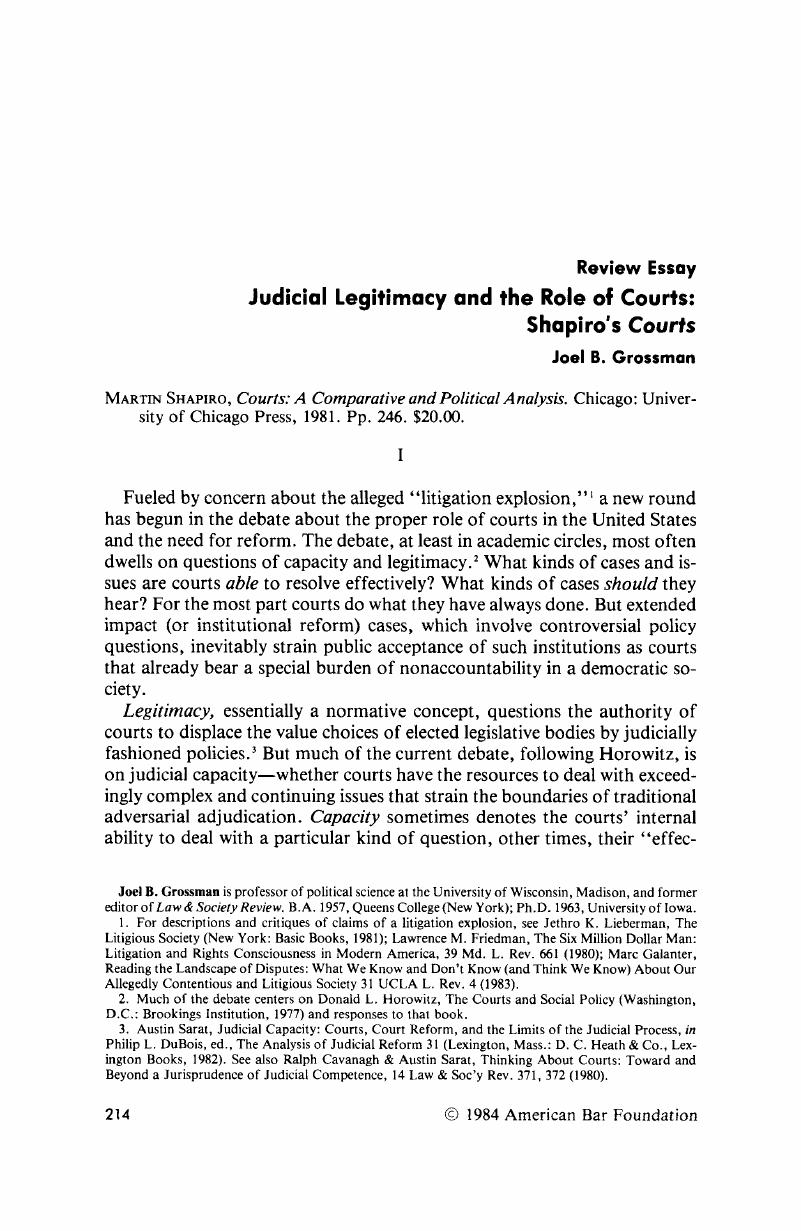Published online by Cambridge University Press: 20 November 2018

1 For descriptions and critiques of claims of a litigation explosion, see Jethro K. Lieberman, The Litigious Society (New York: Basic Books, 1981); Friedman, Lawrence M., The Six Million Dollar Man: Litigation and Rights Consciousness in Modern America, 39 Md. L. Rev. 661 (1980); Galanter, Marc, Reading the Landscape of Disputes: What We Know and Don't Know (and Think We Know) About Our Allegedly Contentious and Litigious Society 31 UCLA L. Rev. 4 (1983).Google Scholar
2 Much of the debate centers on Donald L. Horowitz, The Courts and Social Policy (Washington, D.C.: Brookings Institution, 1977) and responses to that book.Google Scholar
3 Austin Sarat, Judicial Capacity: Courts, Court Reform, and the Limits of the Judicial Process, in Philip L. DuBois, ed., The Analysis of Judicial Reform 31 (Lexington, Mass.: D. C. Heath & Co., Lexington Books, 1982). See also Cavanagh, Ralph & Sarat, Austin, Thinking About Courts: Toward and Beyond a Jurisprudence of Judicial Competence, 14 Law & Soc'y Rev. 371, 372 (1980).Google Scholar
4 Id.Google Scholar
5 Report of the Council on the Role of Courts (St. Paul, Minn.: West Publishing Co., forthcoming).Google Scholar
6 Samuel Krislov, Theoretical Perspectives on Case Load Studies: A Critique and a Beginning, in Keith O. Boyum & Lynn Mather, eds., Empirical Theories About Courts 161, 163–66 (New York: Longman Inc., 1983).Google Scholar
7 Sarat, supra note 3, at 36.Google Scholar
8 Report of the Council on the Role of Courts, supra, note 5.Google Scholar
9 Krislov, supra, note 6.Google Scholar
10 Cavanagh & Sarat, supra note 3, at 411.Google Scholar
11 Fuller, Lon L., The Forms and Limits of Adjudication, 92 Haw. L. Rev. 353 (1978).Google Scholar
12 Id. at 366.Google Scholar
13 For an alternative view of qadi justice, see Rosen, Lawrence, Equity and Discretion in a Modern Islamic Legal System, 15 Law & Soc'y Rev. 217 (198081).Google Scholar
14 Chayes, Abram, The Role of the Judge in Public Law Litigation, 89 Harv. L. Rev. 1281, 1285 (1976).Google Scholar
15 Id. at 1288. Also see Eisenberg, Theodore & Yeazell, Stephen C., The Ordinary and the Extraordinary in Institutional Litigation, 93 Haw. L. Rev. 465 (1980).Google Scholar
16 I am indebted to Professor Thomas Mans for clarification of this point.Google Scholar
17 Chicago: University of Chicago Press, 1981Google Scholar
18 Sarat, Austin, The Logic of Judicial Legitimacy, 66 Judicature 45, 48 (1982).Google Scholar
19 Krislov, supra note 6, at 164–65.Google Scholar
20 Chayes, Abram, Foreword: Public Law Litigation and the Burger Court, The Supreme Court, 1981 Term, 96 Harv. L. Rev. 4, 57 (1982) (quoting Chayes, supra note 14, at 1316).Google Scholar
21 Lawrence M. Friedman, Courts over Time: A Survey of Theories and Research, in Boyum & Mather, supra note 6, at 9, 33.Google Scholar
22 For a discussion of the reality and utility of the myth, see Richard A. L. Gambitta & Marlynn L. May, Judicial Reform, the Myth of the Triad, and the Decline of Confidence in the Courts, in Philip L. DuBois, ed., The Politics of Judicial Reform 69 (Lexington, Mass.: D. C. Heath & Co., Lexington Books, 1982).Google Scholar
23 Adamany, David & Grossman, Joel B., Support for the Supreme Court as a National Policymaker. 5 Law& Pol'y Q. 405 (1983).Google Scholar